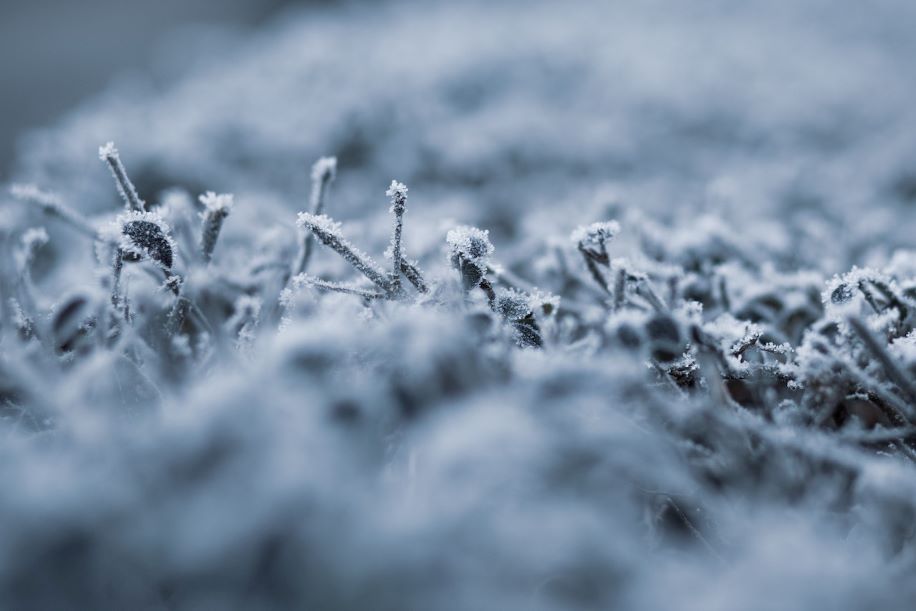Guarding Against the Cold: Plant Care Essentials
By Evelyn Long

The list of landscaping responsibilities tends to shrink during the winter season, but landscapers still need to worry about one thing — the cold. Freezing temperatures can wreak havoc on plant life and leave a yard looking brown and dry by the season’s end. Winter plant care essentials include everything from identifying the risks to protecting different plant species.
To protect plants during the winter, landscapers first need to know all potential threats. Some of these aren’t so obvious:
- Blistering winds combined with the close winter sun can “burn” plants, crack tree bark and cause discoloration.
- Frozen soil makes it harder for plants to absorb water and replenish their nutrients.
- Midwinter warm spells can fool plants into ending their dormancy too early, killing the new growth and stunting the plant’s development.
- Frequent freeze/thaw cycles can loosen the soil and force plants with weak root systems out of the ground.
- Food scarcity during the winter causes deer, rabbits and other critters to eat leaves, twigs and bark more often.
- Heavy snowfall can lead to snow plows damaging plants near the street or driveway.
- Ice-melting agents contain abrasive salts that can damage leaf and root tissue.
Most of these problems are unpredictable, so the only solution is constant maintenance. Every landscaping professional should know these seven fundamentals for cold weather plant care.
1. Be gentle on turf
Landscapers should try to avoid walking or driving vehicles over turf when the ground is frozen. Plants can’t recover as effectively while they’re dormant, so too much traffic could incur permanent damage. It might take longer to regrow in the spring, causing the most affected patches to become eyesores in the yard.
If snow removal is a frequent need, don’t pile the snow in the same spot every time. Snow weighs more than people think, and has caused many roofs to collapse. With that visual in mind, consider how much pressure the lawn is under when covered with piles of snow.
Lastly, try to avoid using deicing agents as much as possible. If they’re necessary, look for products with a potassium chloride blend or calcium magnesium acetate. These chemicals are non-corrosive and biodegradable and won’t threaten plant life.
2. Adjust the watering cycles
Watering becomes less urgent during the winter months. In fact, most plants can survive without frequent waterings once the ground freezes. They’re dormant, so their nutritional needs are much lower than usual. If the soil isn’t frozen, a good rule of thumb is to water plants at midday when temperatures are highest, ideally between 40° and 45° Fahrenheit.
Under these conditions, it’s only necessary to water the plants once or twice a month until the ground permanently thaws in the spring. Landscapers can test the soil with a probe or screwdriver to determine whether watering is required.
3. Use the right pottery
Plastic planters can crack due to freezing temperatures and trap excess moisture, damaging the plant’s roots and leaves. Pottery made from fiberglass, ceramic, terra cotta and other natural materials will tolerate the cold and provide better ventilation. They’re more visually appealing and eco-friendly than plastic anyway, so this change should be a no-brainer.
4. Stop using fertilizer
Plants don’t grow much during the winter, if at all. They don’t produce new leaves or stems, meaning fertilizer is no longer necessary. Even if the weather is unseasonably warm for a few weeks, any new growth will die or go dormant once the temperature drops again. Landscapers should save their fertilizer supply for the spring.
5. Create a winter mulch
Rather than applying fertilizer, spread some winter mulch instead. A mixture of chopped leaves, grass clippings and wood chips covering the ground will protect plants from extreme temperature changes and snowfall. Perennials that landscapers just planted the previous spring and other sensitive species like lavender stand to benefit the most.
6. Trim the foliage
Pruning is an essential part of winter landscaping for several reasons. Keeping plants trimmed allows them to focus strictly on growing new flowers and fruits during the spring instead of reviving all of their overgrown limbs. Frequent winter pruning also reduces the risk of disease and makes the plants less attractive to hungry animals.
7. Use tree wraps
Many deciduous tree species are prone to sunscalding during the winter. It happens when the bark thaws on a warm day and suddenly freezes again overnight, causing chunks to crack and fall off. Landscapers can use tree wraps to prevent this problem and stop animals from trying to eat the bark. They’re also essential for saplings in the first few years of growth.
Although people aren’t too concerned about the appearance of their lawns and gardens in the winter, plant health doesn’t stop being a priority. Keep the discussed threats in mind and use these seven simple strategies to preserve clients’ plants for the spring and keep them happy all year.
Evelyn Long is a writer and editor focused on home building and construction. She is the co-founder of Renovated, a web magazine for the home industry.


